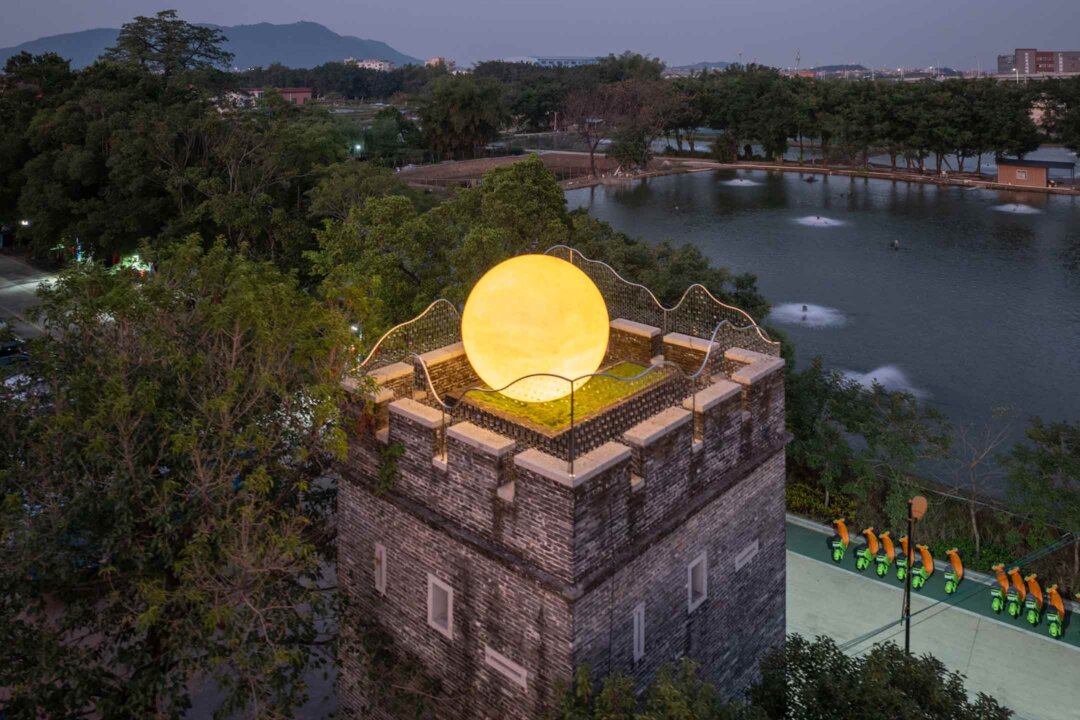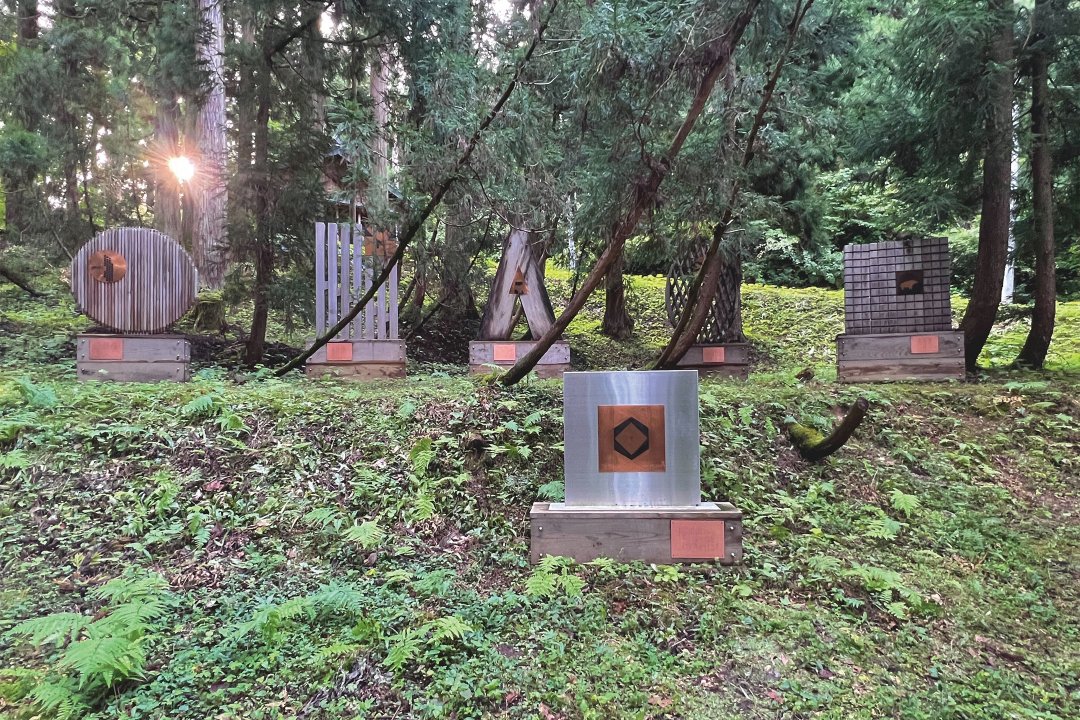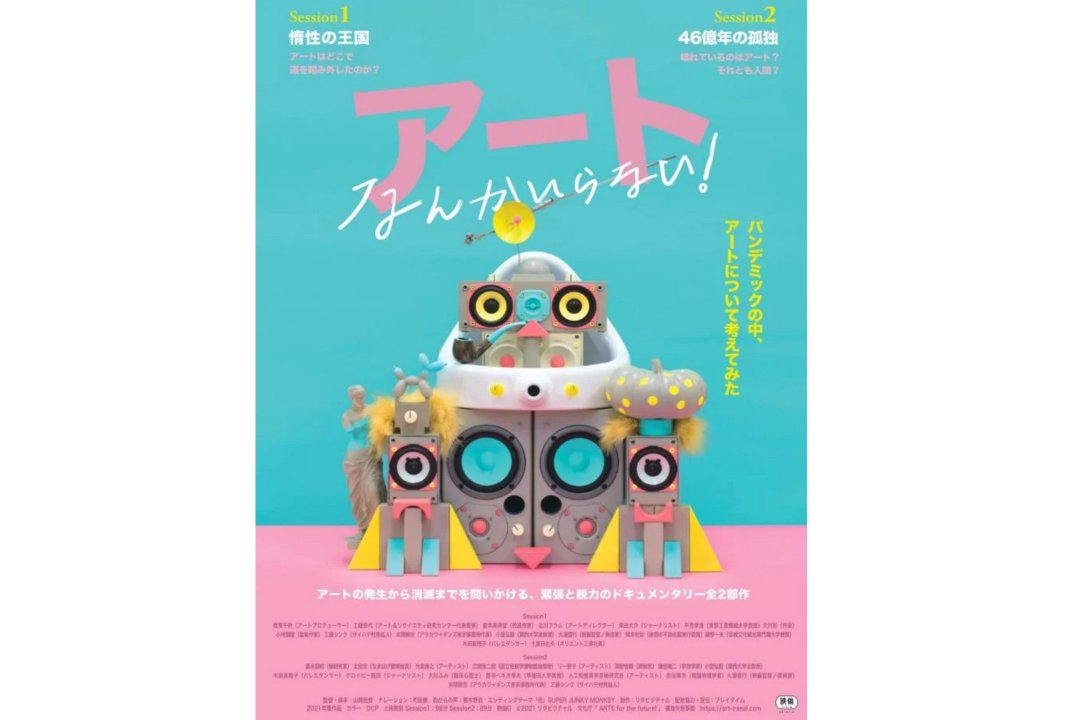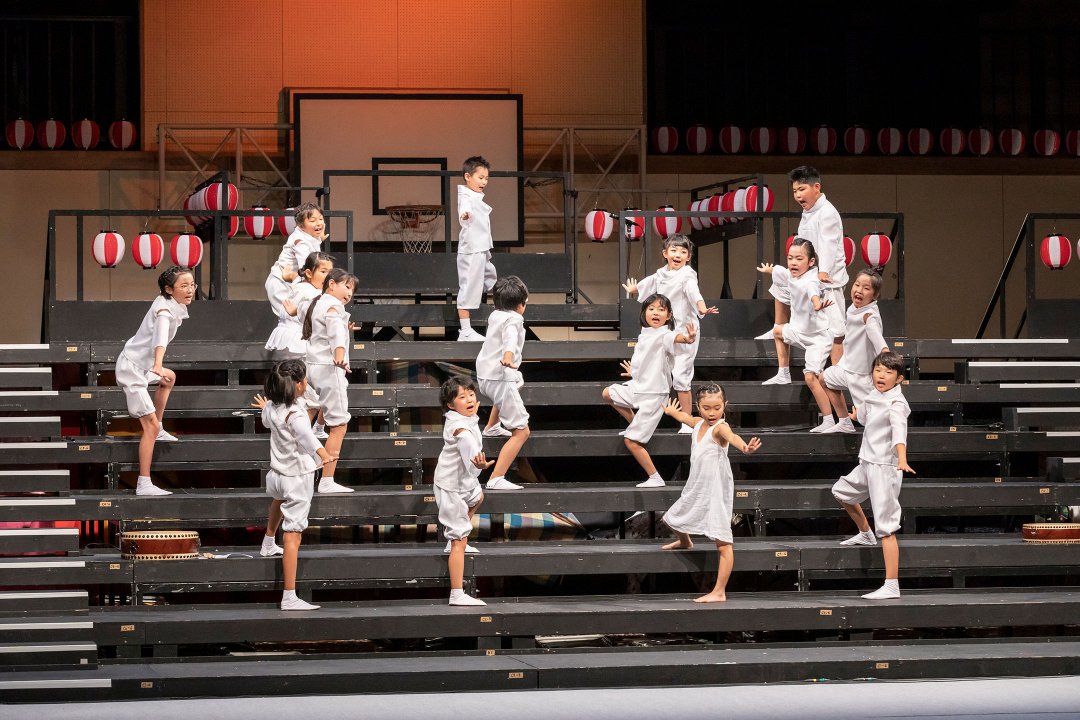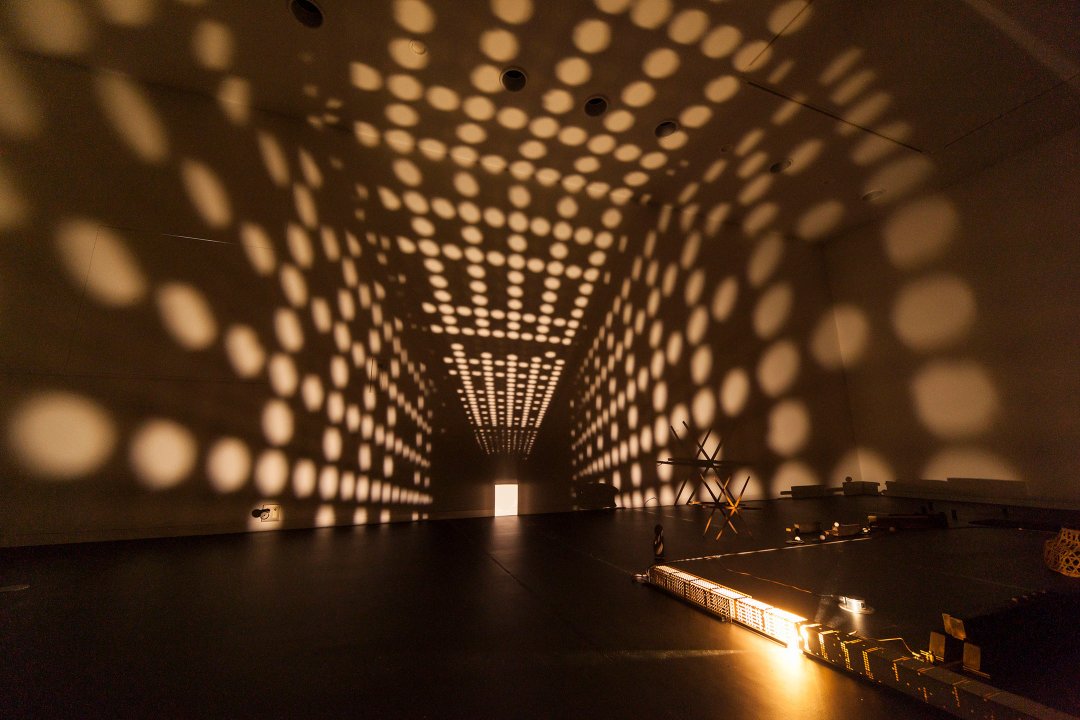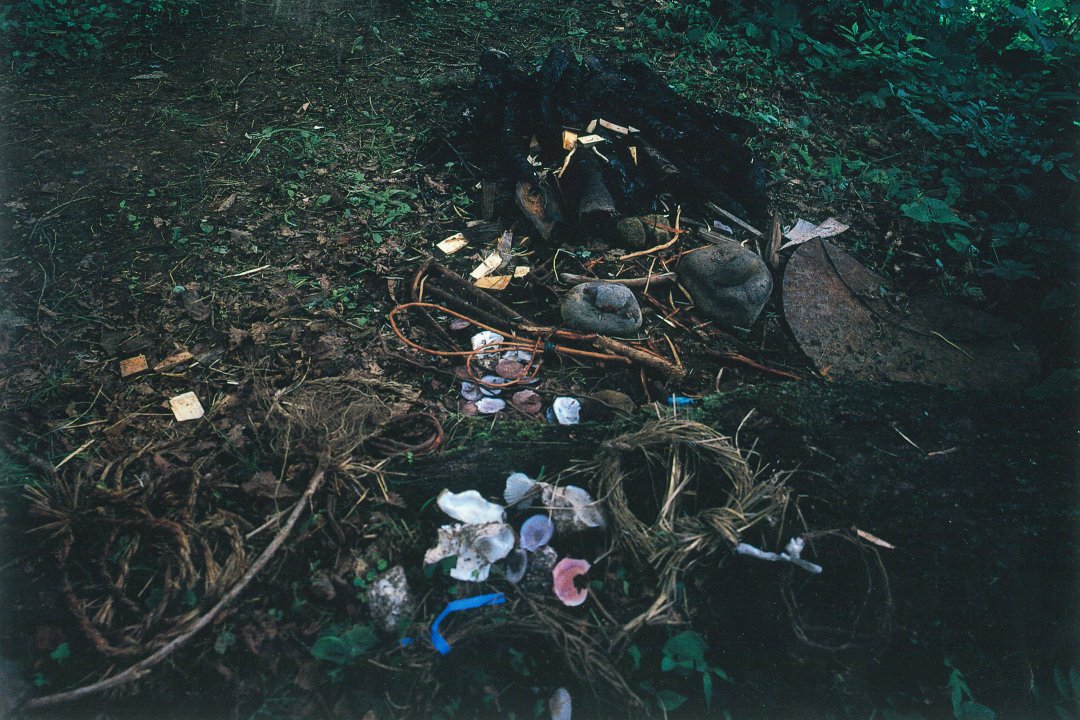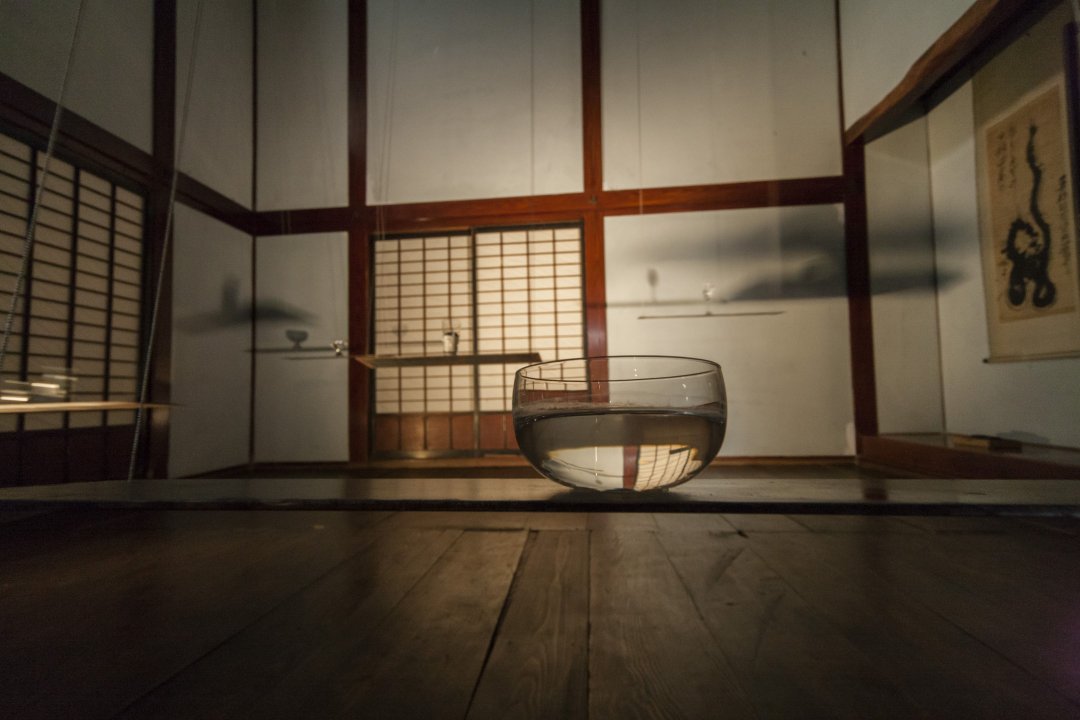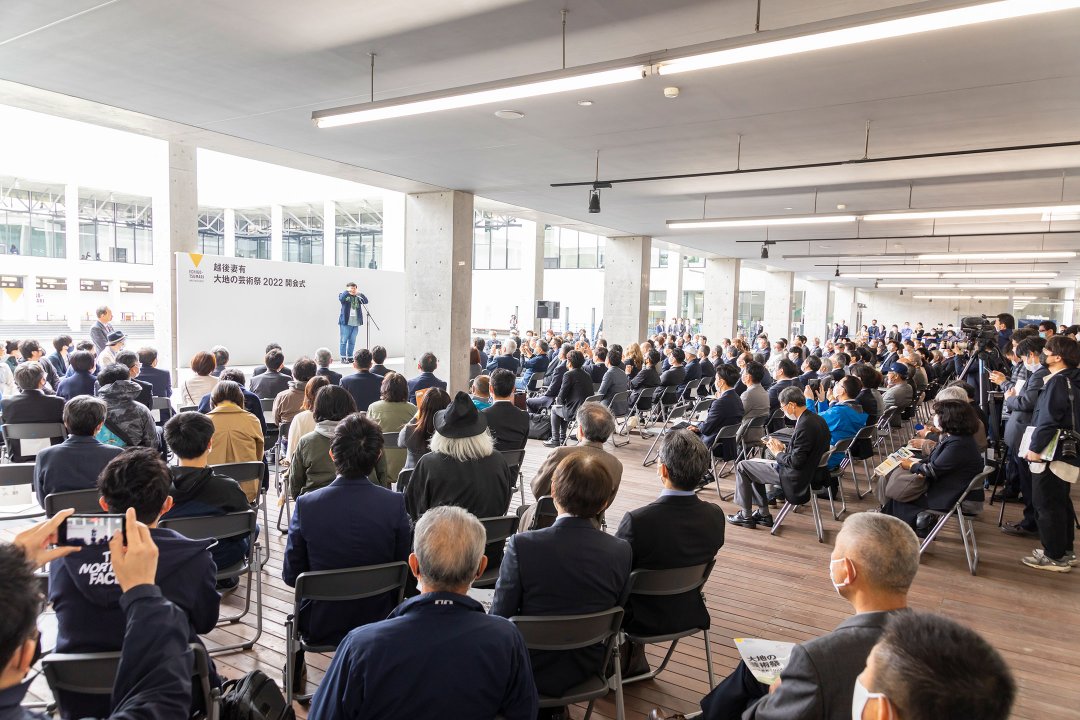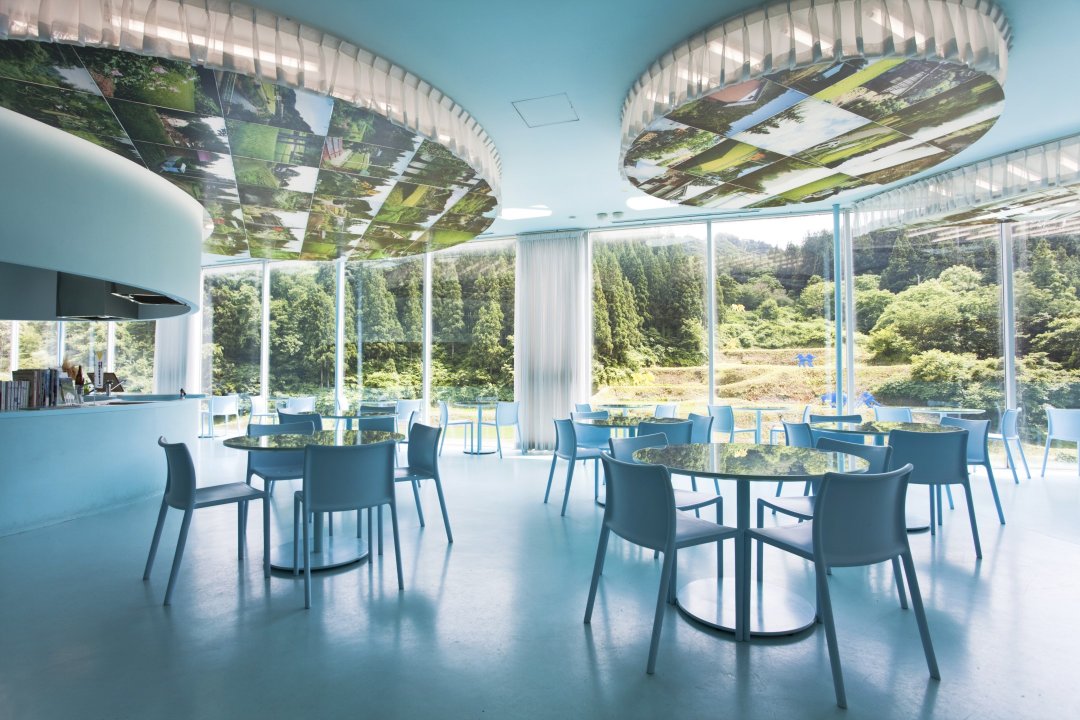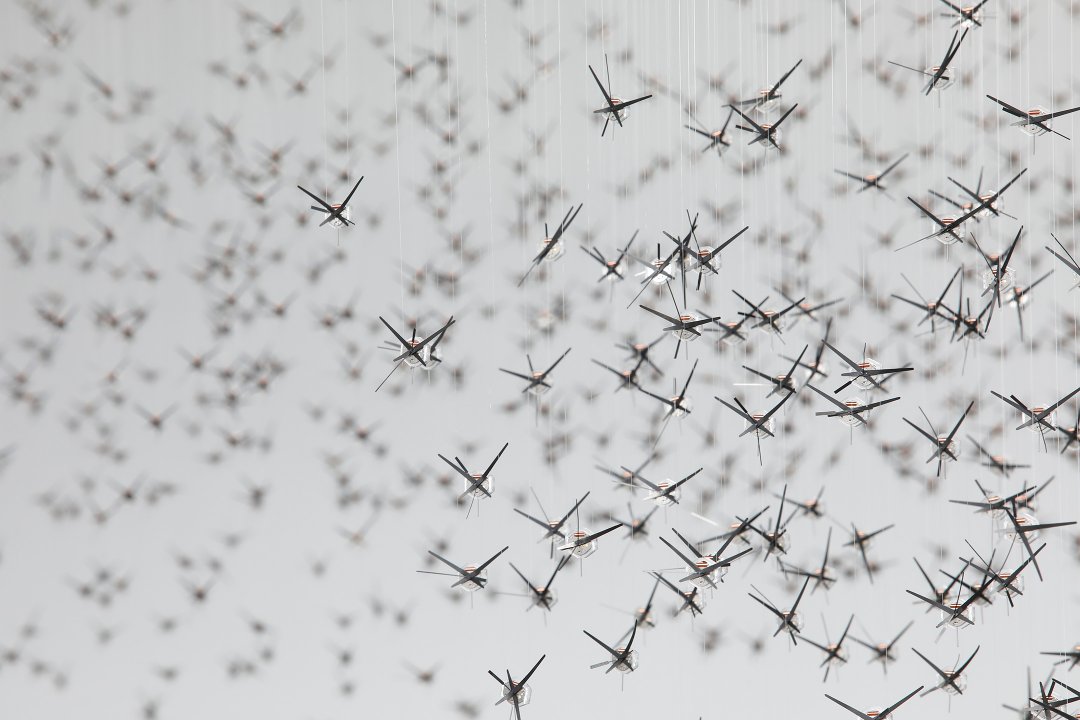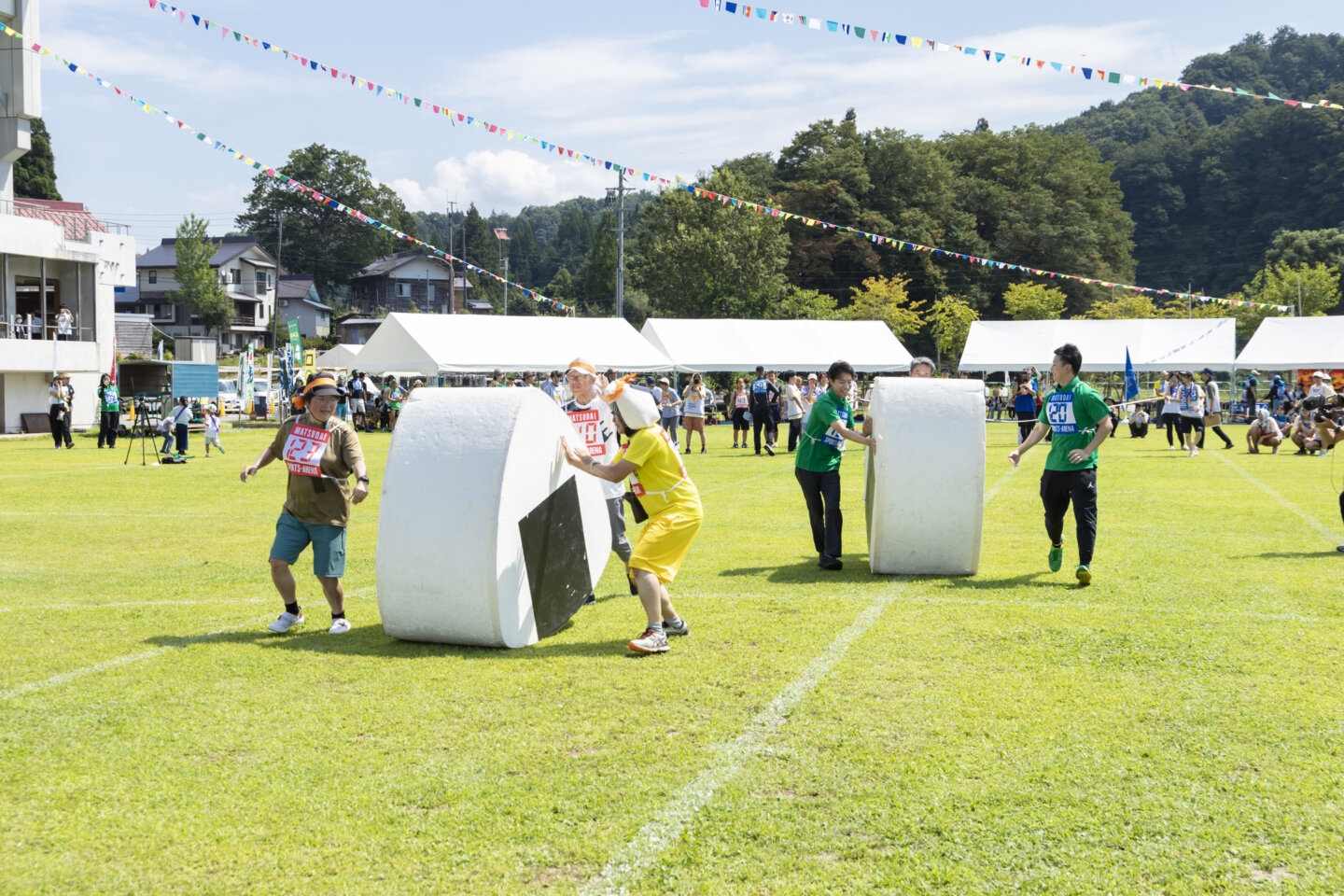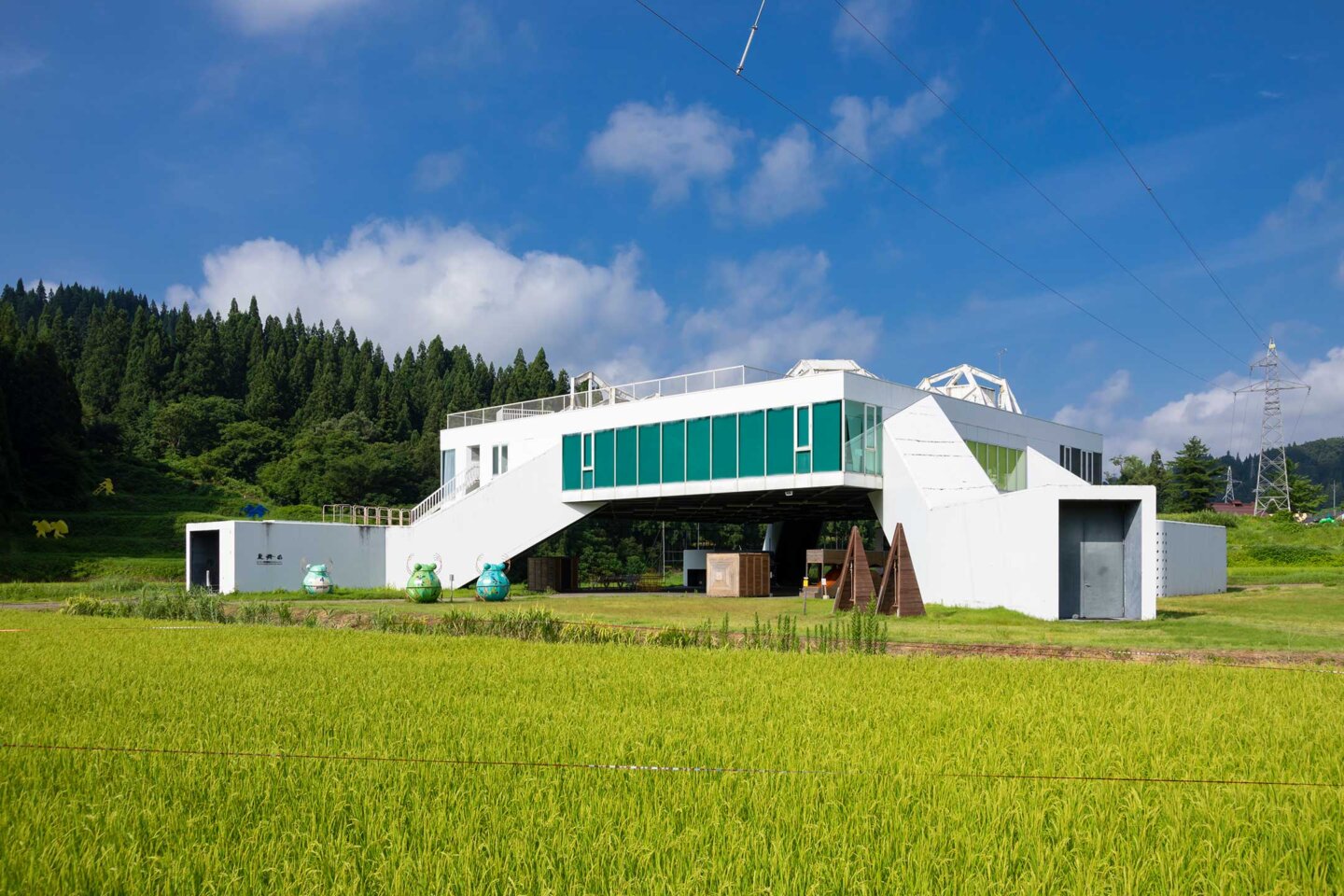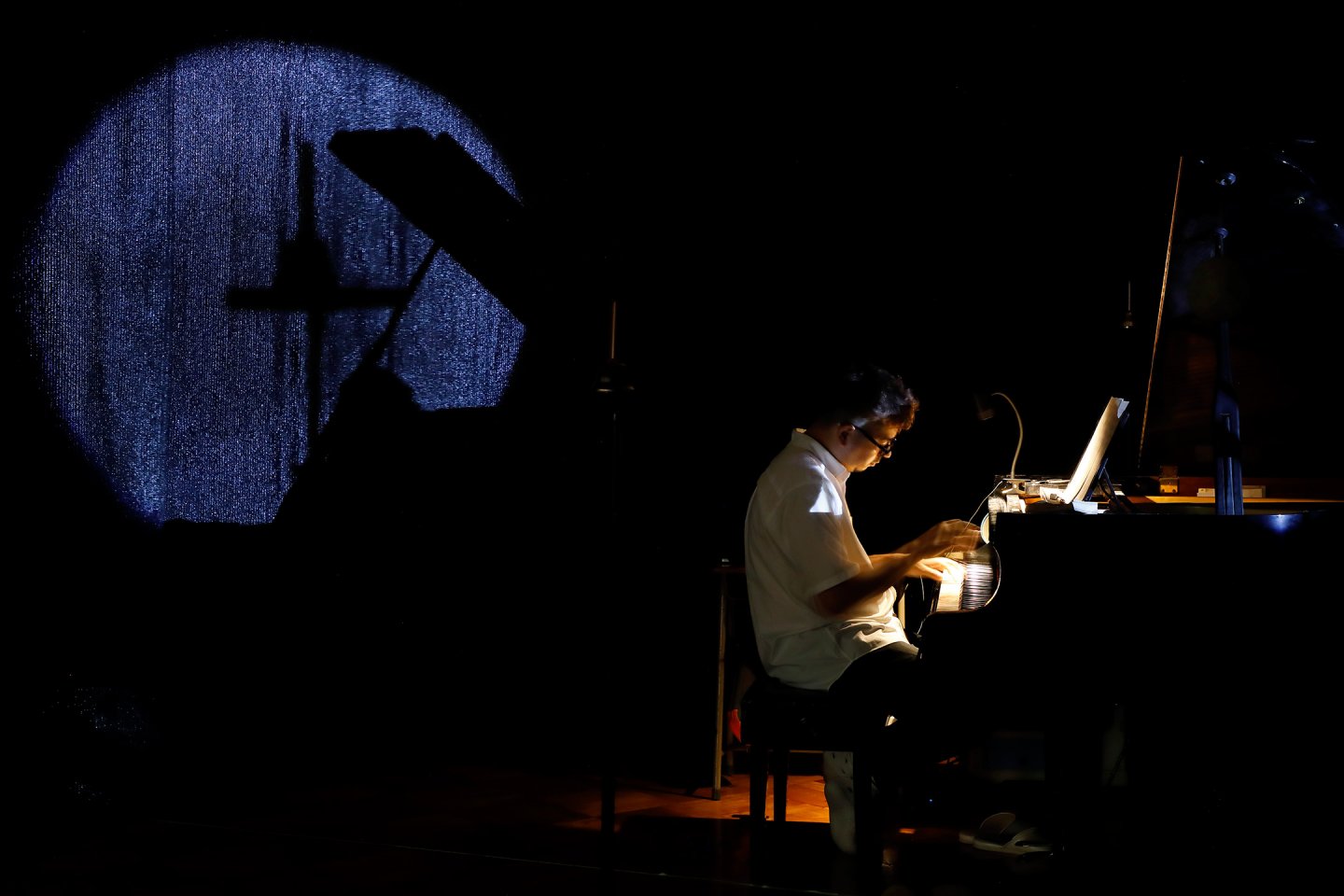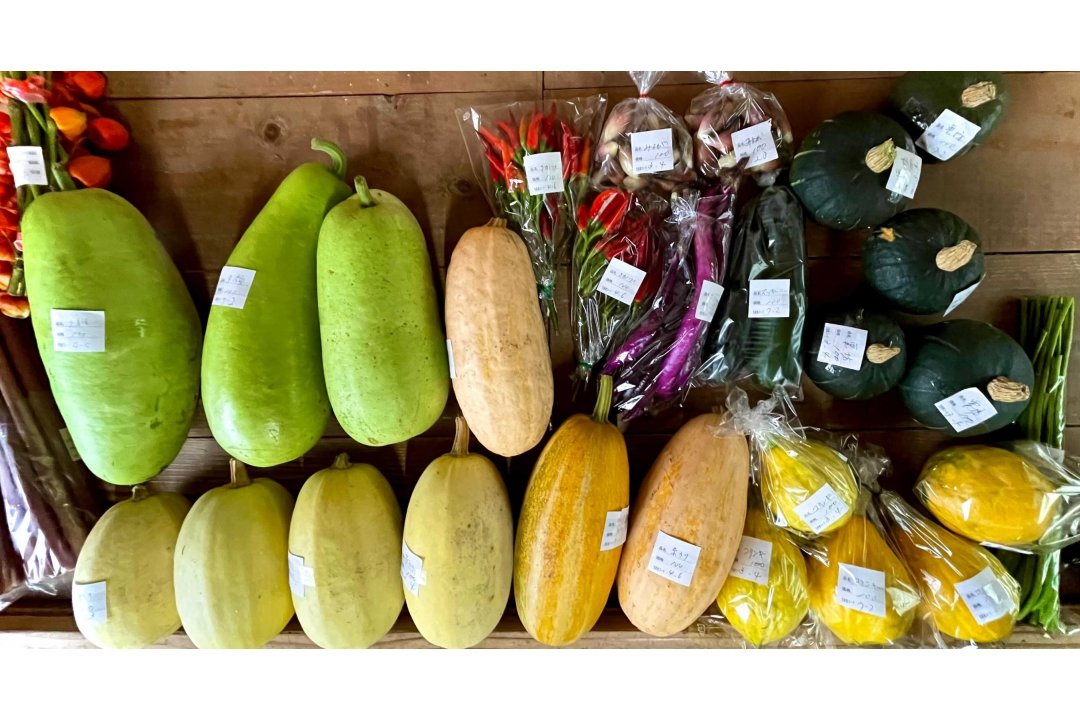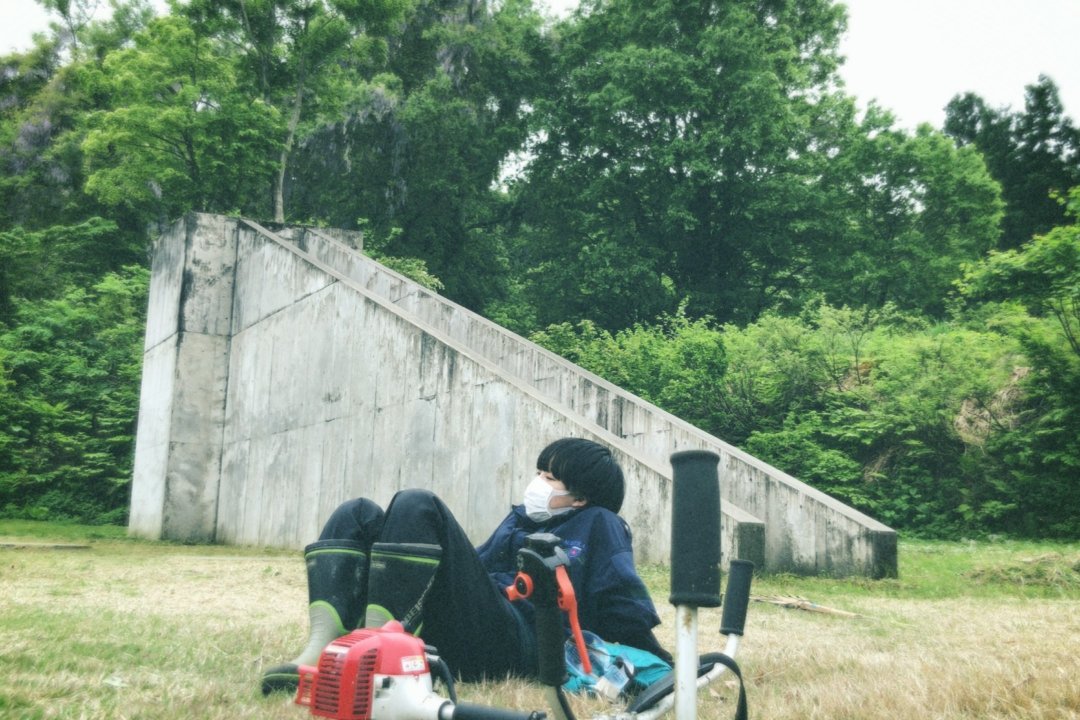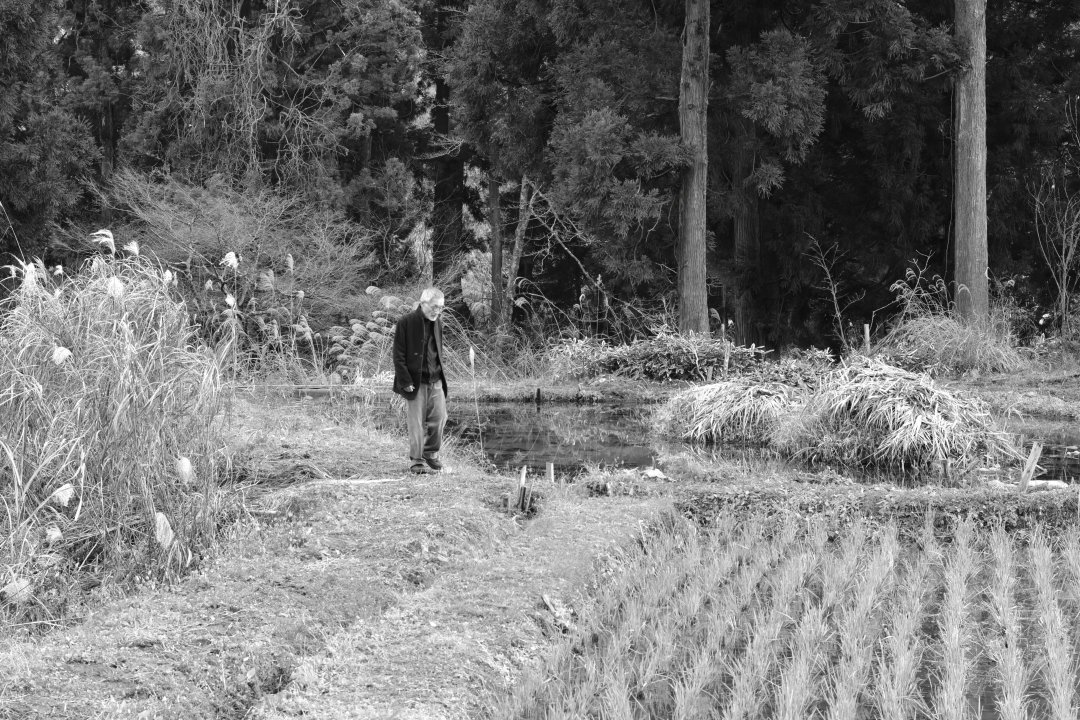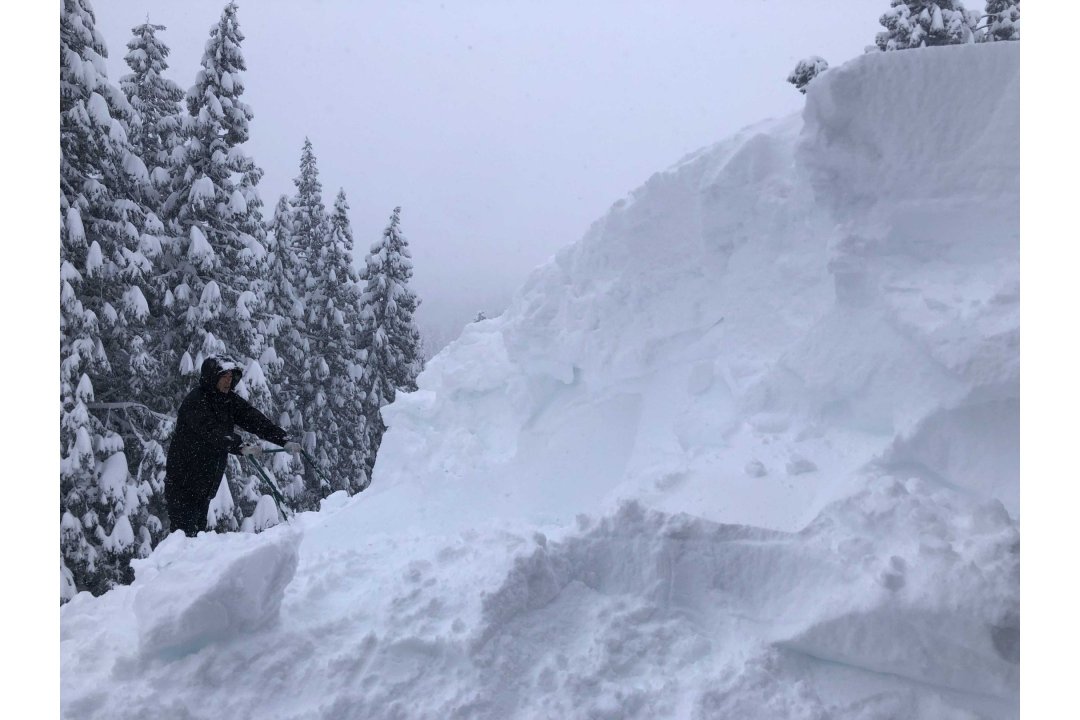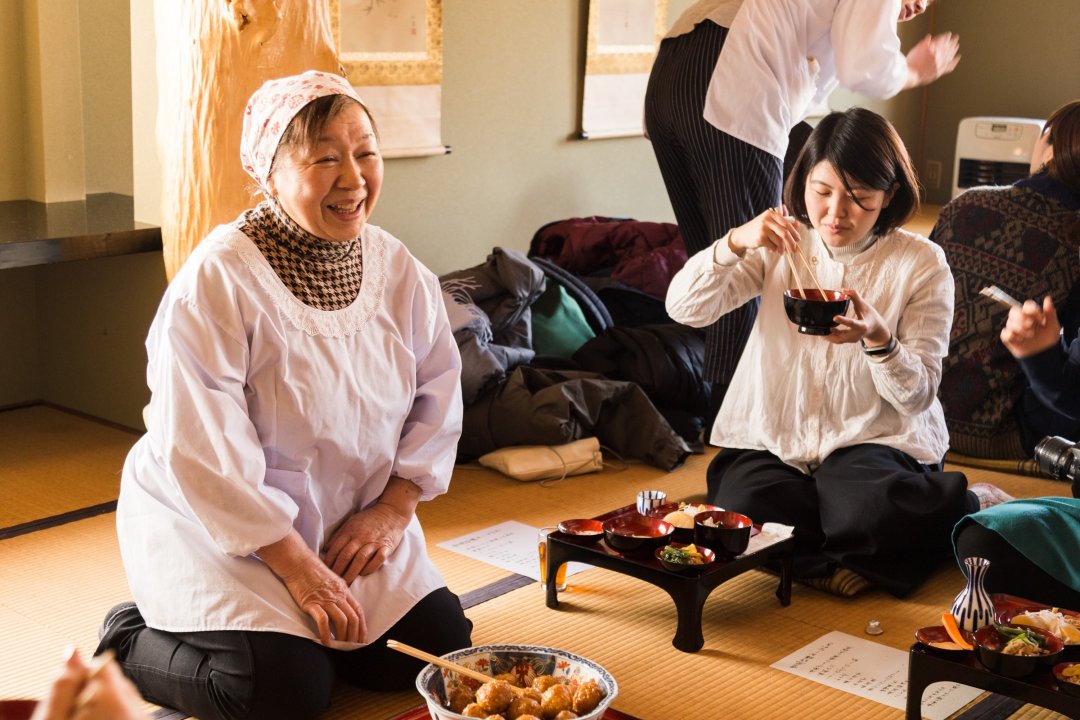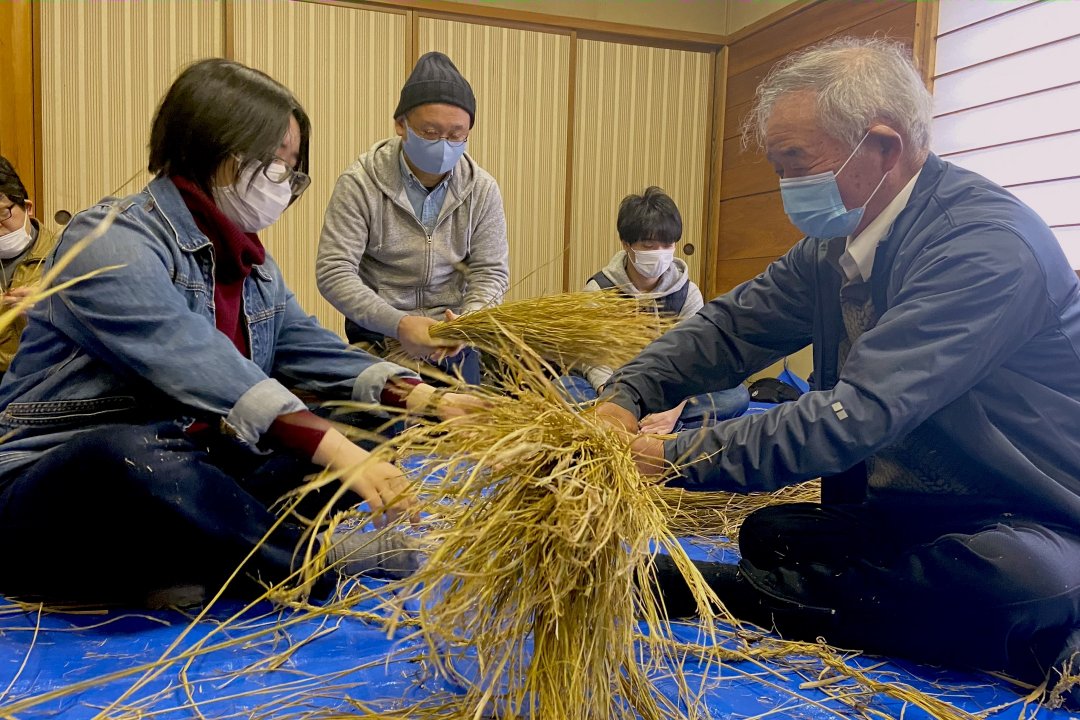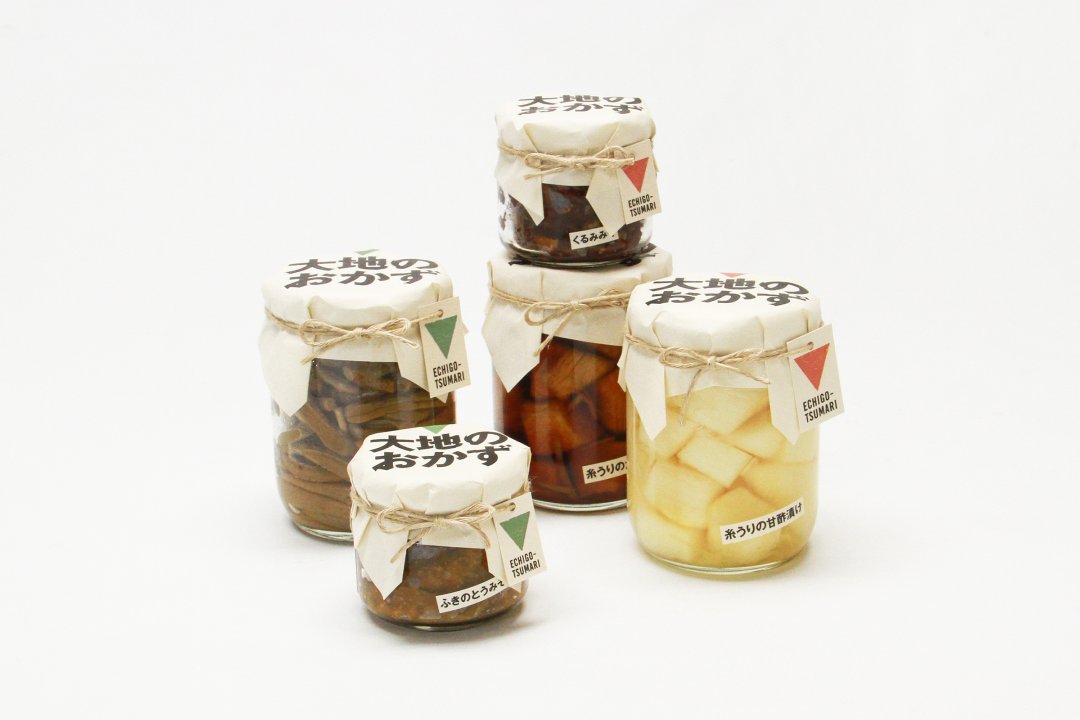Thinking 21st century art in the world from Niigata
Echigo-Tsumari Art Field - Official Web Magazine
Feature / VISITING ECHIG2O-TSUMARI WITH HER, VOL.6-2
Follow the trail of a primitive journey by KOM_I of Wednesday Campanella: An experience of a moment brought by the place
KOM_I (Singer / Artist)
A journey to visit artworks in Echigo-Tsumari with KOM_I of Wednesday Campanella. Following the first half of the journey which made us wonder about spirits and gods, we will have a closer look at the relations of artists, artworks and the region as we explore artworks offering experience of staying overnight which she had been wanting to visit for long time.
Text by NAKAJIMA Haruya, Photo by MAEDA Tatsu, Text & edit by MIYAHARA Tomoyuki / KAWAMURA Kei (CINRA.NET editorial team)
04 December 2020
< Continue to Prequel >
KOM_I ( Prequel )
Follow the trail of a primitive journey by KOM_I of Wednesday Campanella: Returning to the earth in the present era that lost its roots
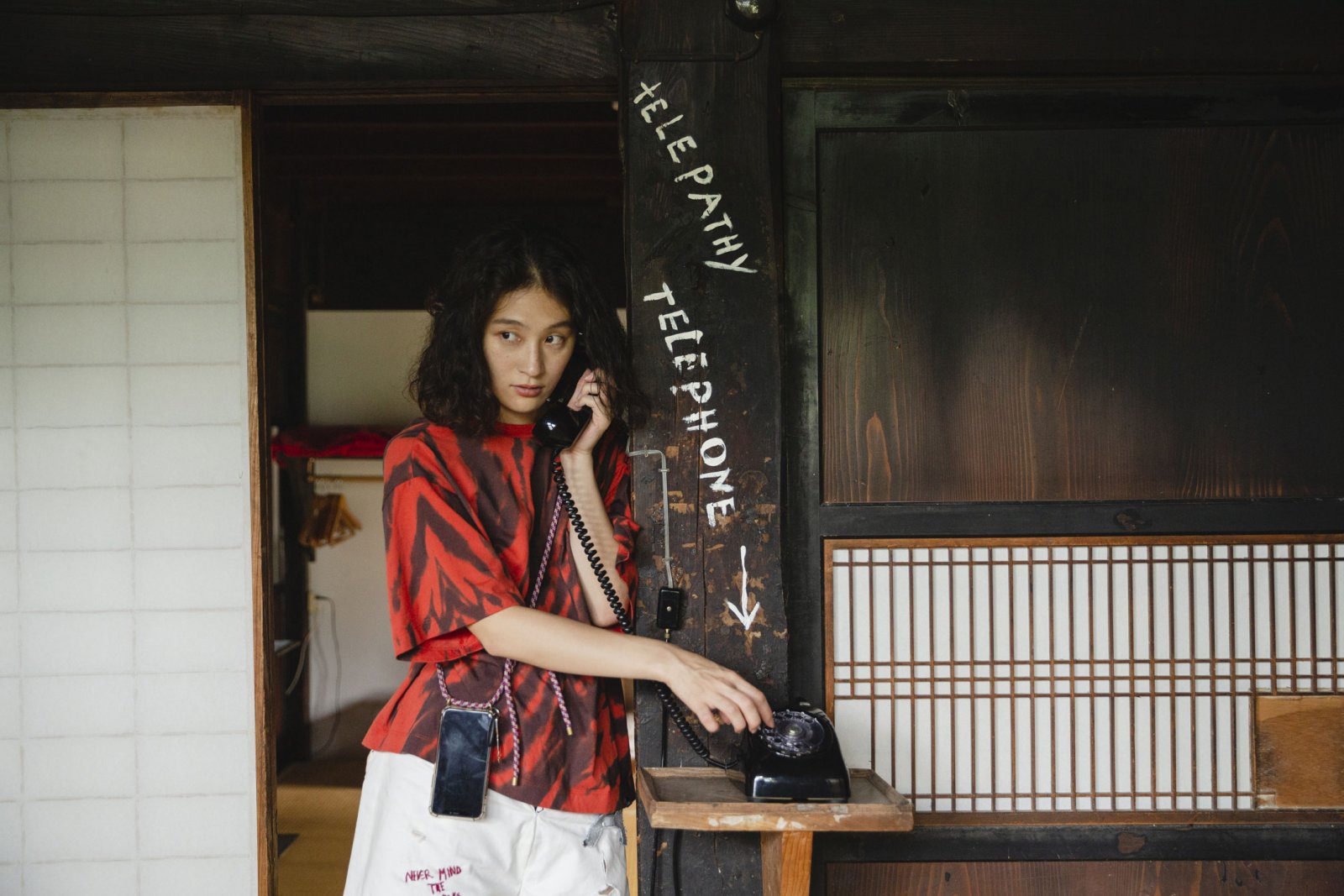
Artworks dotted around in the satoyama landscape
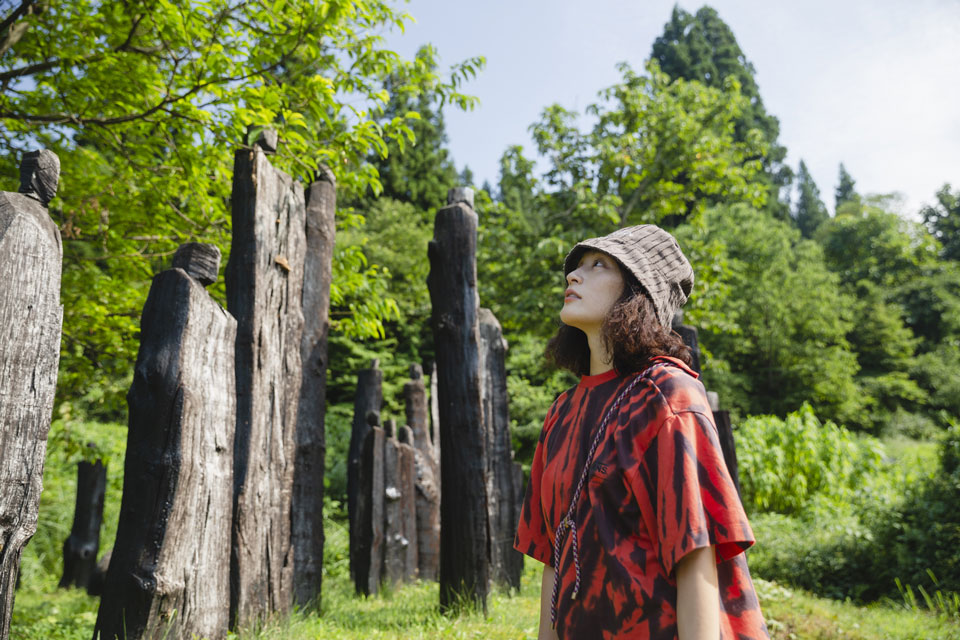
KOM_I
Followed by the journey featured in the previous article, she stopped at artworks on the way to one of the ETAT hub facilities, Matsudai Nohbutai. One of them was “Fort 61” by French artist, Christian Lapie standing in the terraced rice field in the midst of mountain. Pitch black wooden statues surrounding a chestnut tree as if soldiers guarding their own territory.

“The○△□Tower and the Red Dragonfly” to the left behind of “Fort 61”.
Fort 61
Black wood sculptures standing on the terraced rice fields on the mountainside like a village or a group of statues. Creating a world around the place where a house used to be and the memorable trees, the jet-black statues stand in silence, including the life and death of people and history.
KOM_I:Everyone is looking outward. It is strange that we can still recognise them as “face” even they are in abstract shapes. The proportion of the body is more like European rather than Japanese and face is long with well-defined nose. Where are they looking at? They are well integrated in the landscape.
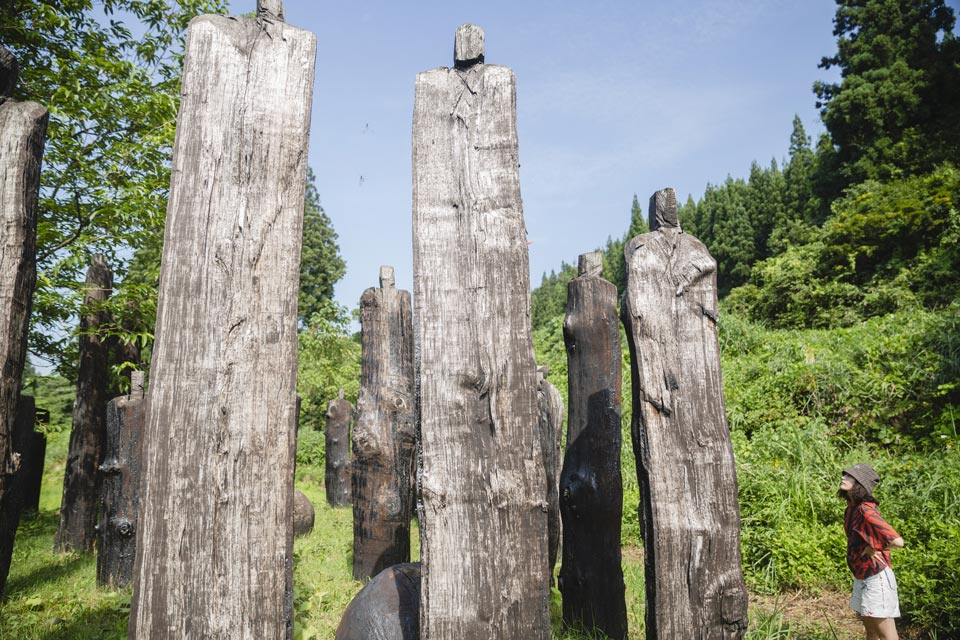
KOM_I looking at “Fort 61” for a while.
Behind “Fort 61”, you will see a sculpture “The○△□Tower and the Red Dragonfly” by Tanaka Shintaro who is known for the minimum expression using dot, line and surface. The red dragonfly flapping vertically is a landmark of satoyama.
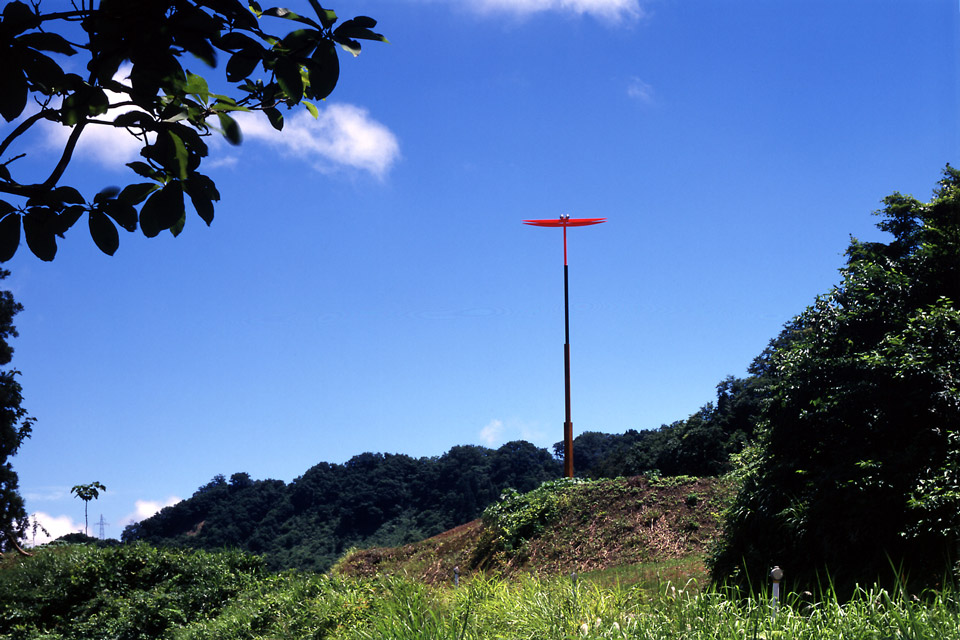
“The○△□Tower and the Red Dragonfly”
KOM_I:A Dragonfly is a symbol of “victory” as it flies only forward. It is believed as something that brings you a luck just like the yukata that you wear at the time of fight has a kimono pattern. A red dragonfly somewhat represents melancholy feeling but the impression of the red dragonfly in this work is exactly a “victory”. The fact that it is flying upwards into the sky makes it more prominent.
“The○△□Tower and the Red Dragonfly”
A fourteen meter-tall sculpture of the Red Dragonfly against the background of blue sky. The landscape with the red dragonfly seen through trees may be the home of heart which connects people living in big city with those living in country side.
As we walked into the mountain after getting off from the car, we found an outdoor library in the forest, “Fichte” by a German artist, Tobias Rehberger. A roundish book shelf and bench are lit up by lighting fixture hunging from the trees. Books in the book shelf are selections of German literature translated into Japanese. The artwork, a library in the forest, represents German philosophy and literature which are compared to “deep forest”.
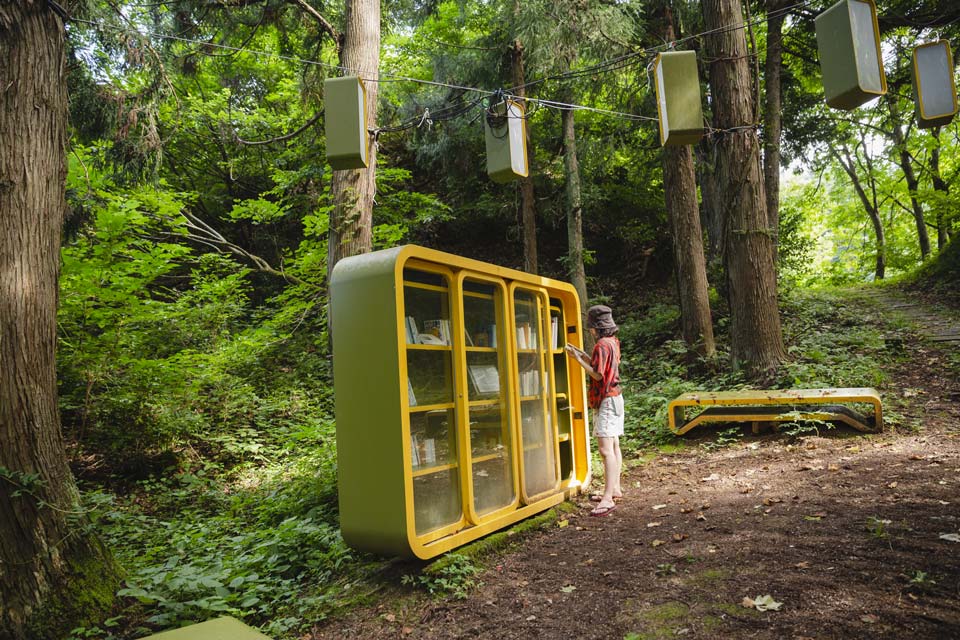
“Fichte”
KOM_I:It would feel so nice reading a book here. It feels like we are in a forest in Europe even except that Japanese cedars with bent root grow here. The feeling of Japanese forest where fox, raccoon dog, and yao-yorozu-no-kami (many spirits) live must be quite different from the image of European forest, home for crows and witch. Being philosophical while reading a book in the forest sounds particularly German. They must have a long winter (giggle).
“Fichte”
The library is located in the discreet place which is almost hidden in the mountain. It can only be reached by foot. The ground of the outdoor library is set up differently from the surrounding area in order to clarify the location. There are a book shelf and bench in the library made of water-proof material. Lighting fixture are hunging from the trees so people can read in the evening (limited time only). The book shelf is filled with selections of German literature translated into Japanese. The reason why having a piece of furniture in a poppy design is because of the artist’s desire to create an artwork which is open to everyone so that it also opens up a door to German philosophy and literature, compared to “deep forest” which are often regarded as difficult. The title of the artwork refers both to a German philosopher and the name of a tree. Many people including publishers helped collect German books.
Being able to experience art as you drive in the regioni is something unique to ETAT.
Terraced rice field where the region resonates with culture
Matsudai Nohutai is a platform called field museum which discover and communicate local assets featuring culture of the snow country and art under the them of “exchange between cities and farm villages”. Visitors can gather information on artworks as well as taste meals using local ingredients grown in Matsudai at the restaurant. KOM_I bought a rice grown in the terraced rice field at the shop.
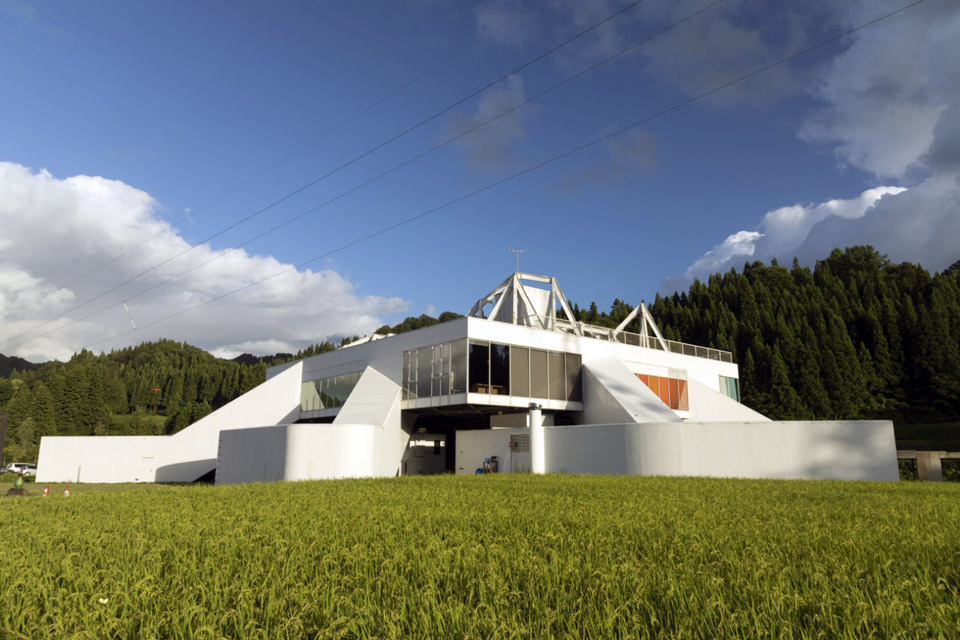
Matsudai Nohbutai
Matsudai Nohbutai
Matsudai area (previously known as Matsudai town) is located in the deep mountain in Niigata prefecture which has hot and humid in the summer while covered with thick layers of snow in the winter, often deeper than 3 meters. Matsudai Nohbutai is adjecent to Matsudai station, standing in between Shibumigawa River and Hokuhoku Line. By floating the building above the ground, the area under the building becomes snow-free zone in winter and cool-shaded piloti in summer while at the same time the building itself can be seen easily from the town spreading opposite to the train track. A rocky mountain landscape appears on the roof which is a “landscape of force” arised from the mechanical needs of the foot-shaped bridge. This artificially created icy landscape on the roof is not only an attractive playground but also a lookout to view mountains and artworks in the landscape. It may also reminds people visiting here in summer of the fact that the entire area is covered under snow in winter.

Having a chat with a staff member selling locally grown vegetables.
From the piloti, you can see a panoramic view of “The Rice Field” by Ilya and Emilia Kabakov, one of the iconic artworks of ETAT. Sculptures in the shape of local people working in the rice filed are installed in the terrace rice field at the other side of the river whereas text capturing the traditional scene of rice production is displayed at Matsudai Nohbutai. You can enjoy the landscape where the text overwrapping with the sculptures in the rice field in distance as you view from the lookout in Matsudai Nohbutai.

“This is much better than the photographs I have seen!” – said KOM_I.
KOM_I:The sculptures are uniquely uneven rather than being flat. Words talk about cultivating, planting, weeding and harvesting rice – which is all about people working in this place. After all, it is not possible to stay serene unless the artwork can deeply engage with local culture.
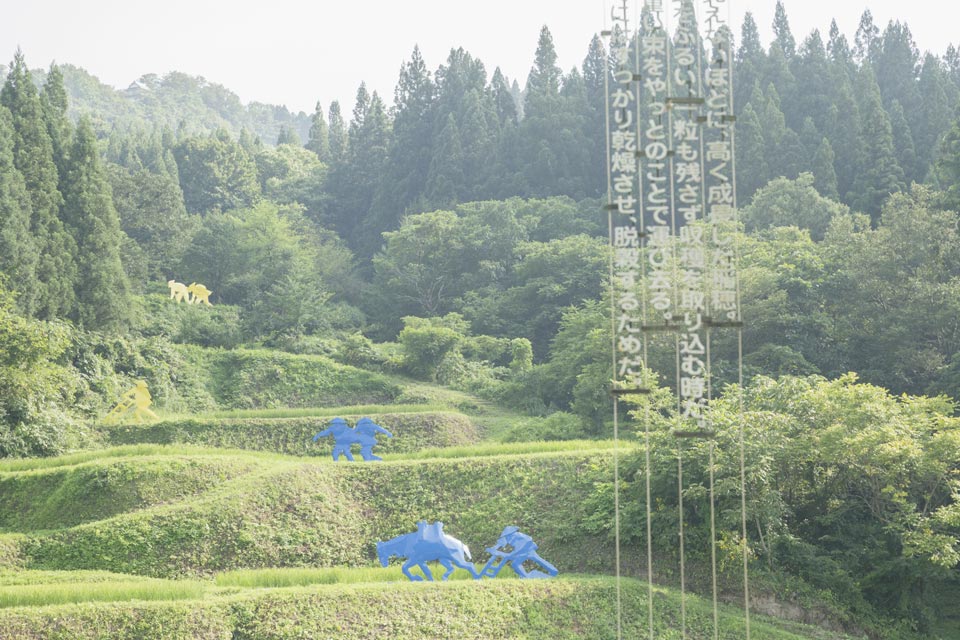
The Rice Field
“The Rice Field”
The artwork consists of text featuring traditional scene of rice production and sculptures in the shape of farmers working in the terraced rice field at the opposite side of the river. When viewed from the outlook in the Matsudai Nohbutai, the text, sculpture and landscape completes the artwork.
In fact, the owner of the rice field was unsure at the beginning but agreed to have the artwork installed after realising that the artists had deep appreciation and respect for the farming culture of this place. The owner was very pleased that the artwork brought many people and let them know about the terrace rice field and farming since then. The ETAT project office has been taken over to look after the terraced rice field after the owner passed away a few years ago.
KOM_I:ETAT and artworks have been a triger for local people to change their perspective, too. People from outside of the region admire the local culture which reminds local people of the values that have been forgotten. Such changes then return positive influence on the artists. This is the artwork filled with emotions and hopes of many people.
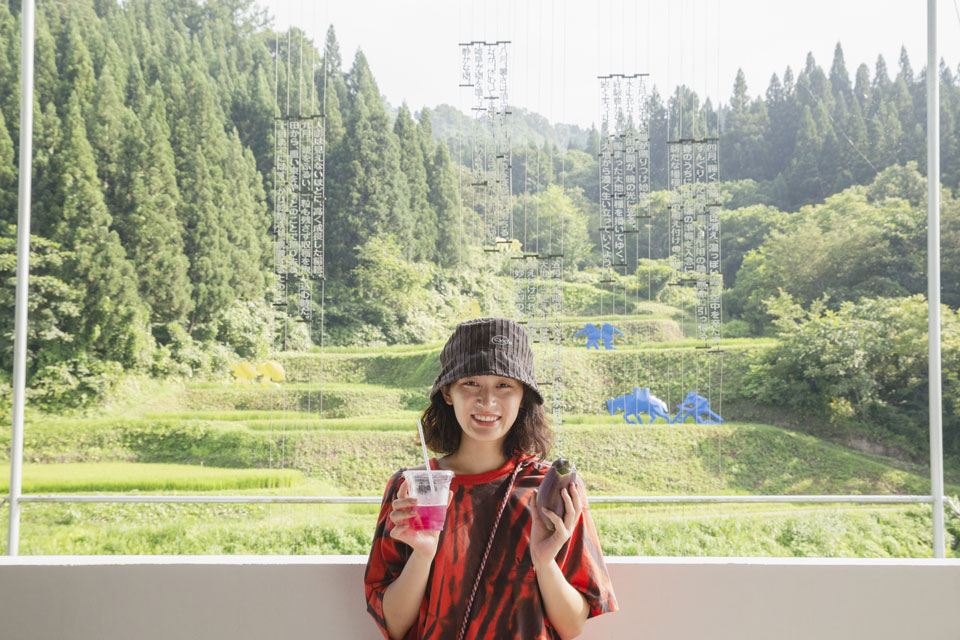
A cup of shiso-juice from the cafe and a round aubergine from verge-shop in hand.
KOM_I picked up a frog she happened to find in the piloti space without hesitation and took it back closer to the terraced rice field. As an artist with such open and free spirit, how does she relate to place and region when she creates her artworks?
KOM_I:The experience of making a documentary “Re:SET” as I stayed in Yakushima has a huge influence on me. For example, I went to a shrine in the middle of the night, set up instruments and sang until morning fell or thought about the place as I played sound in a ruin. It was rather sharmanic as if like a divination.
KOM_I:I find the difference between an image you have of a place which you haven’t been to and an impression you actually feel when visit the place interesting. Such impression is something you get at a particular moment. It could be when you happen to find a scribbling as you walk around the town or the frog I just encountered or the weather – everything that only happens at moment when you visit. I consider how I can capture such whole experience of a particular place including coincidence in my artwork.
A spirit beyond the boundary of an individual one would feel from "Dream House"
“Dream House” awaits you at the hill as you go beyond Matsunoyama Onsen, one of the best three medicinal onsen and climb up the moutain. The artwork which you can stay overnight is a place KOM_I has been long wanted to come is created in the over 100-year-old minka house in 2000 by Marina Abramovic.
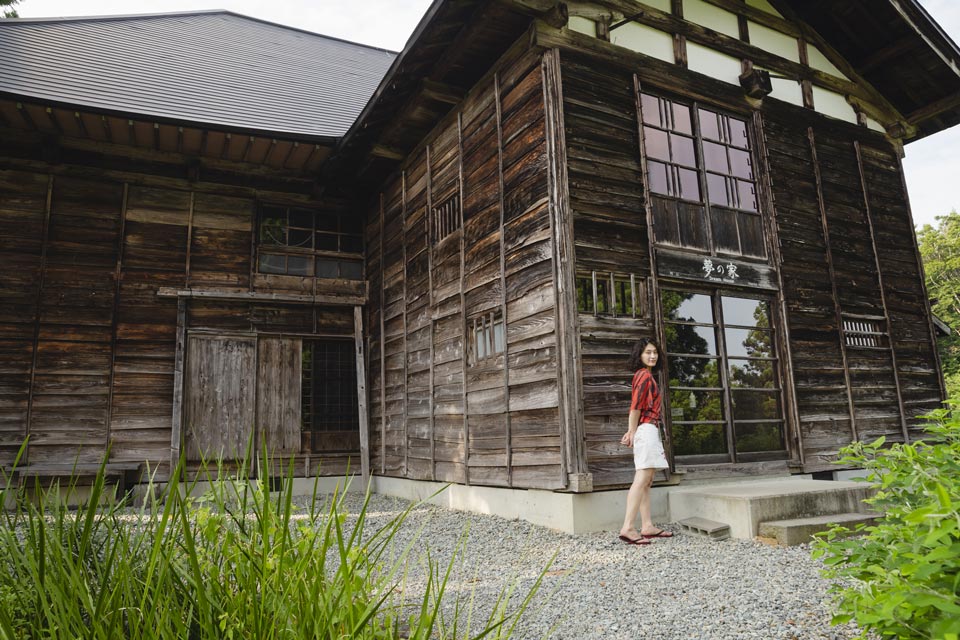
Dream House
Dream House
“Dream House” was created for ETAT2000 by Marina Abramovic as she renovated the over 100-year old minka house standing in the village known for heavy snowfall in winter. At “Dream House” you prepare yourself for the experience of dreaming a dream by putting a special suit on and sleeping in a specially designed bed. You will write down your dream in “Dream Book” which has been published in 2012 as a part of the artwork. Such concept by the artist and local people have been receiving visitors over years. While “Dream House” was not an exception of being damaged by the North Nagano earthquake on 12 March 2011, it managed to re-open after extensive renovation for ETAT2012.
What is most unique is the concept of the artwork. You will put on the suite designed to dream a dream and sleep in the bed, again designed for dreaming a dream and write down your dream in the “Dream Book” on the following morning. While the artwork was heavily damaged by the North Nagano erthquake in 2011, it reopened in 2012 after extensive renovation and “Dream Book” was published in the same year.
As you walk into the room, you will see lots of glass filled on a table. This is in fact a part of artwork. The village was dependent on well for water as the water pipe didn’t exist until 2016. 24 glasses of water with reference to the area size of the house (24-ma), are presented as if worshiping such water from the well.
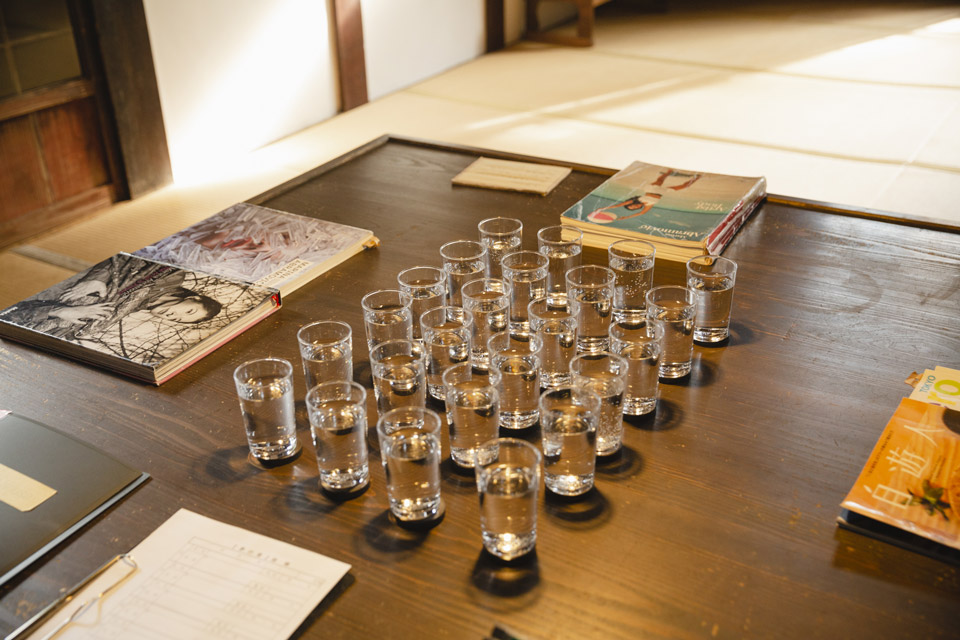
24 glasses of water on the table.
There are four rooms in four different colours, red, blue, purple and green. Each room has a bed for “dreming a dream” which looks like a coffin at first glance. You will spend solemn evening as you feel the natural energy from a pillow made of obsidian.
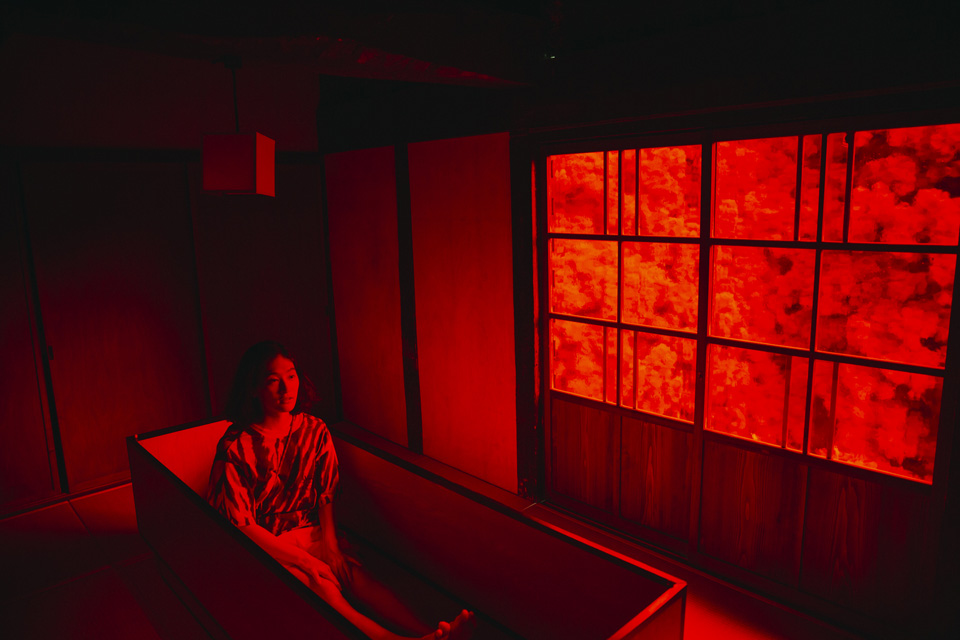
Trying the bed in the red room.
KOM_I:You feel rather comfortable on the stone pillow as you lie down. It looks hard but it feels good to sleep as it is curved. It may work well on people with straight neck. Actually I keep my dream diary. “Dream Book” is kept in the small gap in the bed which makes it easy to pick up. It is perfectly positioned to reach out and it is so beautifully done.

Dreams of past guests in “Dream Book”
Abramovic designed the suite for dreaming a dream. You will put magnets in the pocket to help circulate blood in the body. A message from Abramovic “spiritual recipe” is writen in red ink on the white wall in the living room. KOM_I read out a lout the sentences she was curious about by translating them into Japanese.
KOM_I:“Drink the cocktail of sperm and breast milk in the evening when the earthquake happens”. What is this? It is so interesting! (giggles)
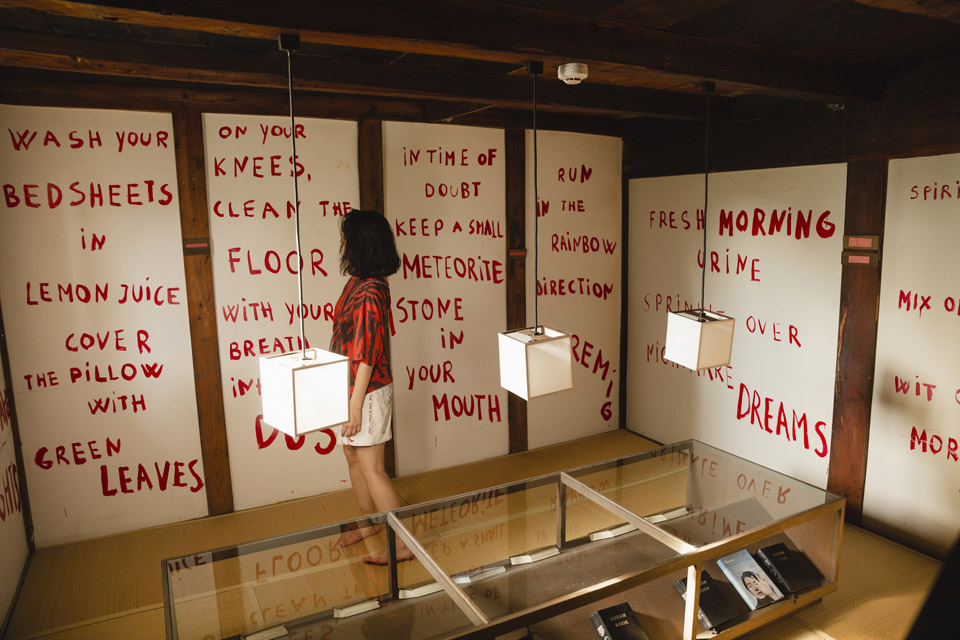
“Spirtual Recipe” by Marina Abramovic
The old classic black telephone is “telepathy telephone”. The village was once out of mobile phone range and it was isolated from the world outside of the village. So Abramovic set up the phone as she thought that “while this telephone doesn’t work, your thought must be reaching out to somewhere.” There is even a bath to cleanse your body before going to bed in order for you to rethink about yourself away from the busy city life. The copper bath tab also has a obsidian pillow and you will take a bath with hearts from the garden.

Pick up “Telepathy Telephone” which no one would answer.
KOM_I:Although the content of dream in “Dream Book” is of course belong to a person who stayed overnight, I feel like this house itself is dreaming. I don’t believe in boundaries of “individual”. People in the same space in the same situation somehow influence one another. For example, just by talking with someone, the way you talk or move becomes similar – you change or “metamorphose” and such sense is very realistic.
When people express something spiritual, it seems like an individual spirit at first glance while it actually not clearly defined. It is not just your own or more than you can remember. While the fantasy of “individual” is still dominant now, I am more interested in something collective. In this regard, “Dream House” where lots of individual dreams come together is very attractive artwork.
The KOM_I’s journey was indeed a pilgrimage – as she was embraced by the nature where spirits and gods inhabit, returned to something primitive and learnt more about your spirit beyond the individualism. Such profound journey will await for you here in Echigo-Tsumari.
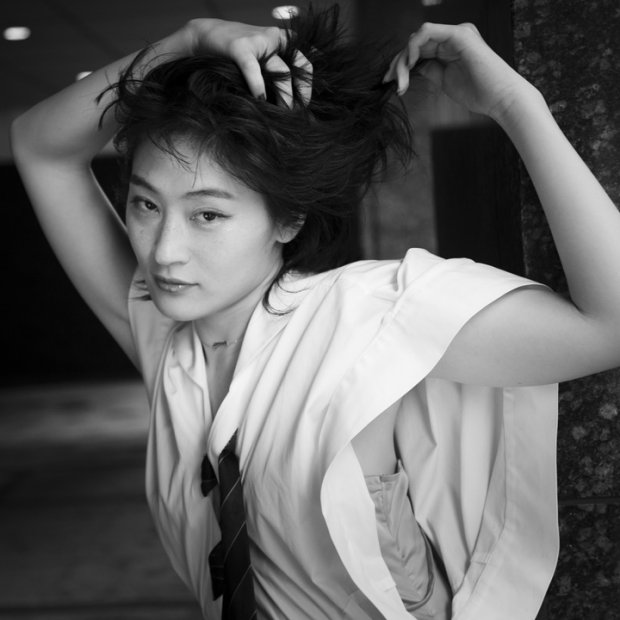
Profile
KOM_I
Singer・Artist. Born in 1992, grew up in Kanagawa prefecture. Invited to join musical activities when she attended a party at friend’s house. As a vocalist of “Wednesday Campanella”, KOM_I performs at music festivals both in and outside Japan, tours around the world and creates live performances that engage with and respond to places she visits and people she meets. She likes southern Indian food and enjoys visiting local rituals and festivals across the globe and learning singing and dancing. In addition to musical activities, she also expands her horizon working as fashion model as well as a narrator. In April 2019, she released “YAKUSHIMA TREASURE”, an EP created with an inspiration from Yakushima, produced by OORU TAICHI.






